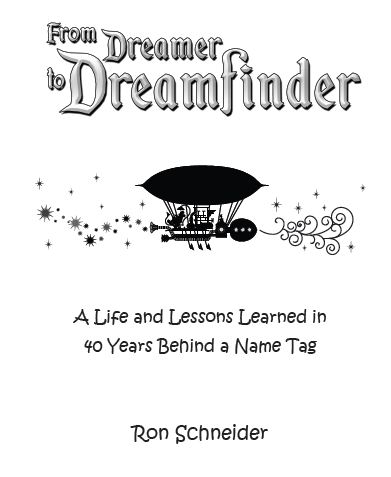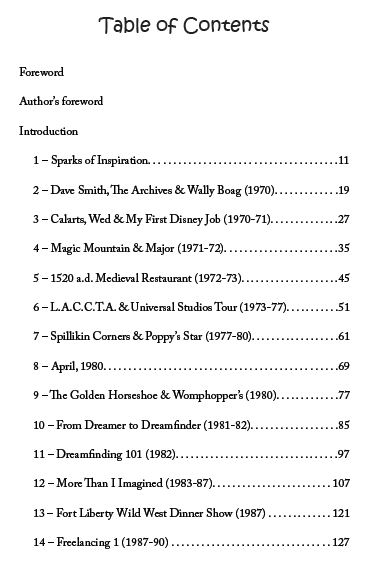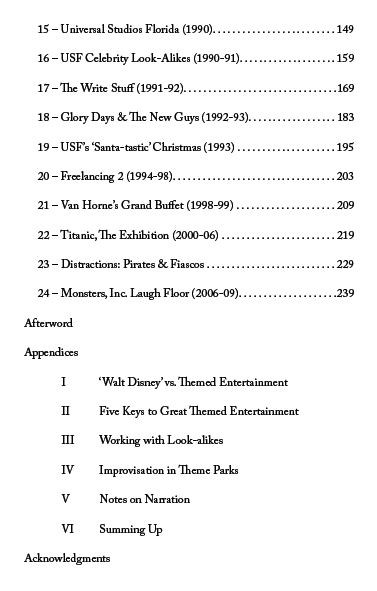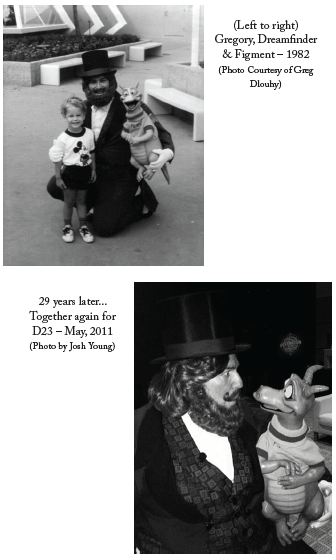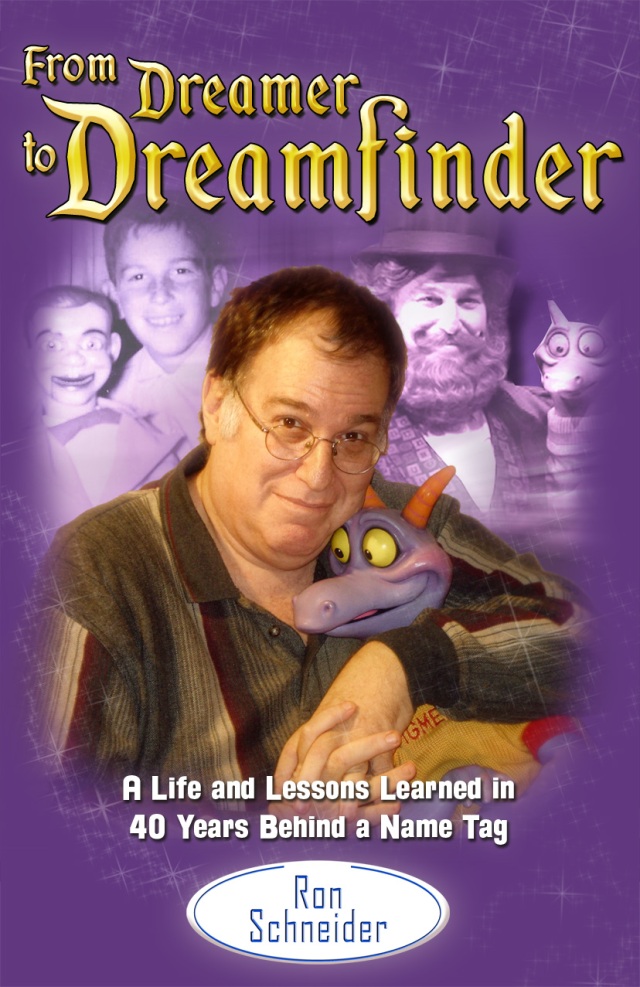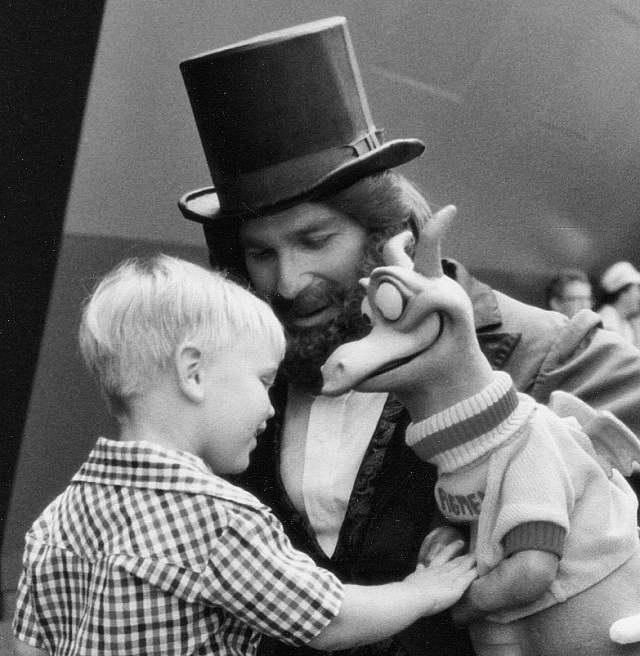From ‘Barrel o’ Fun Magazine: Inside the Industry with Chris Handa

An Interview with Ron Schneider, AKA, Dreamfinder Prime
(Some material is excerpted from Ron’s upcoming book: From Dreamer to Dreamfinder: A Life (and Lessons Learned) from 40 Years Behind a Name Tag)
A few months ago, I saw this guy on some fan video clips, telling stories about his experience as Dreamfinder at EPCOT Center. I found his blog, and learned that not only was he Dreamfinder, he was THE FIRST Dreamfinder, the very first actor to don the purple suit, hold Figment, and greet guests, the press, and celebrities alike. From 1982-1987, Ron set the standard for the first park-specific duo of walk-around characters to be specifically linked to EPCOT.
As I read his blog and learned more about the man, I also learned that his Disney credits include being the voice of Dreamfinder for a portion of the scenes within the original Journey Into Imagination darkride, the voice of the conductor for Mickey’s Birthday land Express (with portions of his audio used in later incarnations of the train script and with style and wording even duplicated by later voice actors), work with the cast of Disneyland’s Golden Horseshoe Revue, and most recently one of the writers and characters on the opening crew for the Monsters Incorporated Laugh Floor (one of the first to play Buddy Boil). Further digging into Ron’s career, I learned that he was there for the opening of (Six Flags) Magic Mountain as well as part of two early area expansions, worked as a guide on the original Universal Studios Hollywood Backlot Tour, was a manager for the opening of several themed restaurants and an actor at many more, and even managed the first celebrity look-alikes at Universal Studios Florida. Halloween and related attraction experience includes being a part of Magic Mountain’s first Halloween event, writing two shows for the first-ever Universal Halloween Horror Nights, and both acted at and wrote the Ghost Tour script for Orlando’s Titanic: The Experience. He even worked with friends on the original Skull Kingdom crew.
Ron is still active in the Orlando area as a writer, consultant, and performer. He was nice enough to sit down with the Handa family and share some of his experiences, allowing me to pose even more questions to him based upon our meeting. In a few brief months I learned more useful information about “Themed Entertainment”, how it relates to our love of dark attractions, and the direction in which it is going than I have in my years of both being a park fan and working for a haunted attraction. We can look forward to reading more from Ron on his blog as well as in an upcoming book. Until then, please enjoy reading my “13 questions” posed to the original Dreamfinder, Ron Schneider:
Chris Handa – What made you want to start a career involving work with amusement parks?
Ron Schneider – As a child I was fascinated with magic and puppetry and started performing at an early age. It was the theatricality of the Disneyland environment that attracted me, the idea that the paying guest was the star on a living stage and the show wasn’t ‘Disneyland’; it was ‘Your Experience of Disneyland’. I came to realize that such an environment calls for a new and different kind of acting, one that focuses, not simply on character or story, but on the guest’s perception and participation. I became determined to learn how that process worked, how you create an environment that tells a story and inspires the guest to participate – physically, intellectually & emotionally. Since I couldn’t find any books or classes on the subject, I realized I’d have to do my own research – by working and performing and studying in the parks themselves.
CH – What challenges did you face when entering into positions involving more responsibility, especially at a younger age?
RS – Long before I was ever hired to perform in the parks I had been studying them for years, and so it felt very natural the first time I stepped up to a microphone at Magic Mountain or took the stage at Disneyland’s Golden Horseshoe. Then, when I transitioned to writing and directing, my performing experience helped me trust my instincts as to what would work and why.
Most of the time I was hired in to solve a creative problem or fill a need for a specific talent, so the people who hired me were happy let me make creative decisions. The challenge came from others – both executives and co-workers – who either wanted credit for what I had created or who had no respect for the themed experience, for the cast members, for the story being told or for the guests. People like that will tend to rely on what has worked in the past rather than try to find the creative solutions that will address the new challenges every project presents.
Whatever other challenges I might have faced were easily conquered by the nature of the business. Since what we were doing was fun, folks were happy to pitch in and contribute their best work as long as I let them know they were a valued part of the process. That’s what Walt Disney did and I’ve found that it still works today.
CH – Can you share a little of your experience as a voice actor for attractions?
RS – Like any performer, I started by imitating what I admired. I learned all the Disneyland narrations back in the sixties and seventies, so I was familiar with what worked in those venues. When I was put in front of my first microphone I parroted a lot of that material, but – like a stand-up comic – I gradually tried my own stuff while watching and listening to see what worked with the guests. I learned to be a ruthless editor of my own material – if it didn’t get a laugh or the reaction I was looking for, I’d cut it out.
Being able to recreate the sound of the Dreamfinder for the attraction got me my first recording job. While I was in the studio, I carefully messed around, just a bit, to let the people I was working with know that I was capable of doing more than the one voice.
Back at home, I was always practicing my cold reading skills so I could pick up any kind of copy and quickly give an intelligent reading. That skill, along with being pleasant and flexible and being able to take direction got me a lot of work through the years.
The most important thing in narrating for the parks is to develop a warm ‘real’ delivery. Too many performers start by over-modulating their voice, developing a pattern of inflection they think will give their reading life and energy. Listen to them for any length of time and all you hear after a while is their inflection; like listening to Charlie Brown’s teacher in the cartoons – a rhythmic pattern with no content. Instead, think of your audience as a close friend who’s sitting next to you in a moving car. Speak warmly and intimately, and focus on communicating the ideas in the copy rather than the words.
CH – What changes have you seen in attractions over your many years, especially from the position as an actor and writer?
RS – The changes I’ve seen tend to be technology-related: new ride systems, projection systems, and pyrotechnics. In my field of live performance, the major parks still rely primarily on the musical revue, the walk-around character and variety performers (jugglers, puppeteers, mimes, and acrobats). At Disney and Universal parks, you’ll always see the re-telling of a story from a movie and what has come to be known as ‘streetmosphere’ – face characters, improv troupes and wacky tourists.
Occasionally a truly unique performer or character will slip through and make an impression, but they are the welcome exception. Dreamfinder was one such, not because of anything we did as performers, but because of the strong connection between the concept of EPCOT Center in the eighties, the Journey into Imagination ride story and the characters. Each expanded on and reinforced the other.
Disney tried putting live actors in The Great Movie Ride but could only take the experiment so far. The most exciting work being done in atmosphere entertainment I find is at regional Renaissance Faires, where the interactive performers write and manage (and fend for) themselves, and in interactive guided experiences like ‘Titanic the Experience’ in Orlando or ‘5 Wits’ in the Boston area.
CH – “Themed Entertainment” is a niche that we may not necessarily think about when we are looking at the nuts-and-bolts operation of dark attractions. What is your definition of “Themed Entertainment” in relation to these experiences?
RS – Students who are assigned to write a ‘theme paper’ are asked to expound upon one particular idea. A ‘themed’ experience does the same thing; all the elements in an attraction are focused to put across a single story or feeling. In the themed show the designer or storyteller deals creatively with operational realities, so all the technical elements disappear in service of the story being told. Dark attractions are, by their very nature, themed… that’s why they’re dark. We use those nuts-and-bolts to create an environment that, once the lights are out, transcends its reality to become a personal experience for the riders.
CH – After reading about your experience and meeting you, it is clear that seasonal entertainment in relation to year-round venues has been a part of your career going all the way back to Magic Mountain. Can you share a little about your experience with seasonal experiences within the larger scope of a year-round tourist destination?
RS – My experience with seasonal events have been unique because the ones I’ve worked on have been inaugural creations, where a park is trying – for the first time – to create something new out of an existing operation. Everything we created those first years was accomplished by in-house talent so we were feeling our way, doing what we thought would be fun.
Our first Halloween at Magic Mountain the holiday theming was restricted to the Spillikin Corners Crafts Village. I was assigned to animate a suit of armor located next to the blacksmith’s forge; this meant I had to stand in a large plywood box behind the armor and pull a rope that would raise one arm of the suit, hopefully startling nearby guests. In this job lasted exactly 15 minutes before I walked away, looking for some other way to contribute to the event. I wound up putting on a black robe and grabbing a giant rubber rat. I asked the blacksmith to fashion me a long fork… and I wandered slowly through the village with the fork in my hand and a smile on my face – chewing on the rat’s rubber head. Made quite an impression, especially on the ladies.
12 years later I got to write and direct the shows for Universal Studios Florida’s first Halloween event, called Universal Studios’ Fright Nights. Everything we did had to be foraged from what we already had. By combining the abandoned sets from Psycho 4, our Beetlejuice look-alike and our musical Blues Brothers act with some pyro and a chainsaw we created a totally new show, the Beetlejuice Graveyard Revue.
CH – Can you name a few things that most of us as park fans don’t think about in terms of working day to day as a park employee or manager?
RS – A big challenge of any job is dealing with repetition; the folks at “World Wide Wickets” must crank out so many hundreds of wickets every day to remain in business. Now imagine what would happen if every one of those wickets was in danger of having its feelings hurt? In the attraction business we don’t deal with inanimate wickets, we’re dealing with human beings with egos, expectations, special needs and ulterior motives; and we have to do it one person at a time. This takes tremendous discipline to keep the show fresh, especially when the weather hits or the crowds turn ugly.
The challenge for a manager is even harder… they have to manage the people who manage the people. But the manager of a new attraction has one valuable asset in this effort: the momentum of opening. The new cast, pulling together to get the fledgling park up and running, is unified and focused in a way they may never be again. The smart manager will seize on that feeling, will nurture it and keep it alive long past opening. You can’t buy goodwill like that… and it’s harder than hell to recapture it once it’s gone. I was fortunate to work at Disneyland in the early eighties, before the coming of the Eisner regime. The people who ran the park were still the folks who had worked under Walt and that feeling of doing it for him was still very much alive.
Later, when I was working at EPCOT Center, the focus changed. We were told in no uncertain terms that we were expected to generate 20% annual growth. Fiscal success is a wonderful business plan, but it’s a lousy incentive for generating good customer service and employee morale.
CH – You’ve been a part of many “firsts” from the opening of several destinations to seeing the iconic Dreamfinder opening animatronic in its production phases. To what do you attribute to being involved on such an intimate level with so many fledgling projects?
RS – There can be no argument that – when it comes to the wide variety of jobs I’ve had and the challenges I’ve faced – I’ve been outrageously lucky. I was born in Southern California in September of 1952, greatly increasing the odds that I would be, as I was, in attendance on Disneyland’s first day of regular operation. I was the perfect age to open and grow with Magic Mountain Amusement Park, and used that experience to make me the perfect candidate for Universal Studios and Disneyland in 1980… and so on and so on throughout my life.
Of course, there was more involved than timing; there was the very human instinct to Follow My Bliss. The love of theater, of performing, of magic and puppetry and Disneyland drove me from a young age to acquire the knowledge and experience I’d need when I was finally presented with those opportunities.
The final thing I would need to realize my dreams was the people… the wonderful friends, family and fellow performers, competitors and collaborators, teachers and employers who would cheer me on, boost me up, tutor and challenge and give me a break. In that, I was unendingly lucky.
CH – The “names” you have worked with, particularly within the amusement industry, are pretty impressive. Can you share any of the interactions that have been major influences through the years?
RS – Once again, timing meant everything; I seemed to stumble on the right people at the best possible times. I met Disney Studio Archivist Dave Smith just as the Archives was starting, so I was the first lucky outsider to tour the archives, long before everything was locked away behind glass and file cabinets. I got to handle the cels of Mickey’s debut cartoon, Steamboat Willie and page through the giant storybooks that opened each of the Disney Classic Animated Features. Dave’s been a great friend since 1971. Being discovered by Jay Stein, President of MCA Attractions, just as he was looking for a figurehead for his $3 million theme restaurant Womphopper’s Wagon Works was very lucky and led to creative positions in both Hollywood and Orlando.
Coming in to the Disney family when Sonny Anderson & Ronnie Rodriguez were managing the Talent booking department was lucky; they really made you feel appreciated and supported in your work. The star of Disneyland’s Golden Horseshoe Revue, Wally Boag, was a wonderful inspiration all my life. Then, when I was hired to understudy Wally, I got to work with the lovely Betty Taylor and the amazing Fulton Burley. Through thousands and thousands of performances of the Golden Horseshoe show, they kept it fresh and funny; I learned so much from watching and working with them.
It was surely the luckiest day of my life when I happened to attend a seminar by Tony Baxter about careers in Disney Imagineering, where he shared a picture of Dreamfinder & Figment, the new characters created for EPCOT Center. Soon after, Tony sat me down and shared the characters’ history and inspiration, gifting me with one of the best roles I’d ever have.
CH – A lot of what you have mentioned and written about includes the loss of control over a concept, script, or even overall presentation. When is this good thing as a part of the development process and when does it weaken the product presented to the guests?
RS – Since we are creating living environments that are meant to be experienced by paying guests, loss of control is inevitable. Whatever we do isn’t finished until you open the door and let the public in. Only by watching, listening to and accommodating the guest can any attraction reach its full potential and hope to be around for the long haul.
The best jobs I’ve ever had or managed thrived in an atmosphere of benign neglect. By hiring the right people, training them properly, letting them know they are appreciated and then encouraging their creative efforts, I’ve seen the people working for me do more and better work than I could do myself. I stressed to my people at Universal Studios Hollywood & Florida that I was their biggest fan and they repaid me with great work and good times.
CH – Where do you see Themed Entertainment having the most influence upon dark attractions in the future?
RS – Theming has been influencing dark attractions since the days of Coney Island, when indoor attractions were first used to tell a coherent story. Back then, the popular culture relied on books and newspapers for diversion, so attractions were based on the works of Jules Verne and Dante and spectacles recreated news events of the day or exotic locales.
Disneyland was partly inspired by the requests Walt Disney received from the public to let them come to the studio and see how the animated cartoons were made. Instead, he used dark rides to put the guests in the cartoons. In the years that followed these environmental attractions grew more artistically and technologically sophisticated.
Where a family on Snow White’s Scary Adventures might be startled and amused by the experience, the feelings created in the Pirates of The Caribbean and the Haunted Mansion are more subtle. I think this evolution is still in its infancy. As this generation of theme park designers and dark ride fans mature, they’ll find ever more potent and exciting ways to tell stories and thrill the guests.
CH – What do you feel is your biggest influence upon the legend and legacy of the original Journey into Imagination and EPCOT Center?
RS – Inspired by the ideas presented in the Journey Into Imagination attraction and all of EPCOT Center, I was determined not to let the characters of Dreamfinder & Figment be reduced to just another photo opportunity; I used my interaction with the guest to illustrate and involve them in the creative process. I borrowed a page from the Imagination Ride, treating the people we encountered as sparks of inspiration – they became objects for study. When I would ask a small child, “What are you?” their carefully considered response was a delight to see and made an impression on them and the folks they were traveling with. Thus, I was able to capture and stimulate the imaginations of the children and families I encountered.
That the Dreamfinder & Figment are still fondly remembered and inspiring to people is a tribute to Tony Baxter and the Imagineers who created all of EPCOT Center in the eighties. That was a special place with a powerful theme and mission that has been diluted in recent years by the desire to make the park all things to all people. Back then, it was ‘An Inspiration Park’. The world could certainly use such a place now.
CH – Please share any information that you care to divulge in relation to current and upcoming projects, as well as anything that you would like that I may have missed in the previous questions.
RS – I’m working on a concept for a new themed dinner attraction that will be a comical twist on the notion of the ‘character meal’. I’ve hooked up with a talented business partner and we hope to have something that will surprise Central Florida theme park fans and visitors early in 2013. I’m putting the finishing touches on a combination memoir and textbook, about live themed entertainment, From Dreamer to Dreamfinder: A Life (and Lessons Learned) from 40 Years Behind a Name Tag that should be available within the year! Excerpts from the book – and my own editorial musings about the attraction industry – can be found online at http://www.dreemfinder.wordpress.com.

